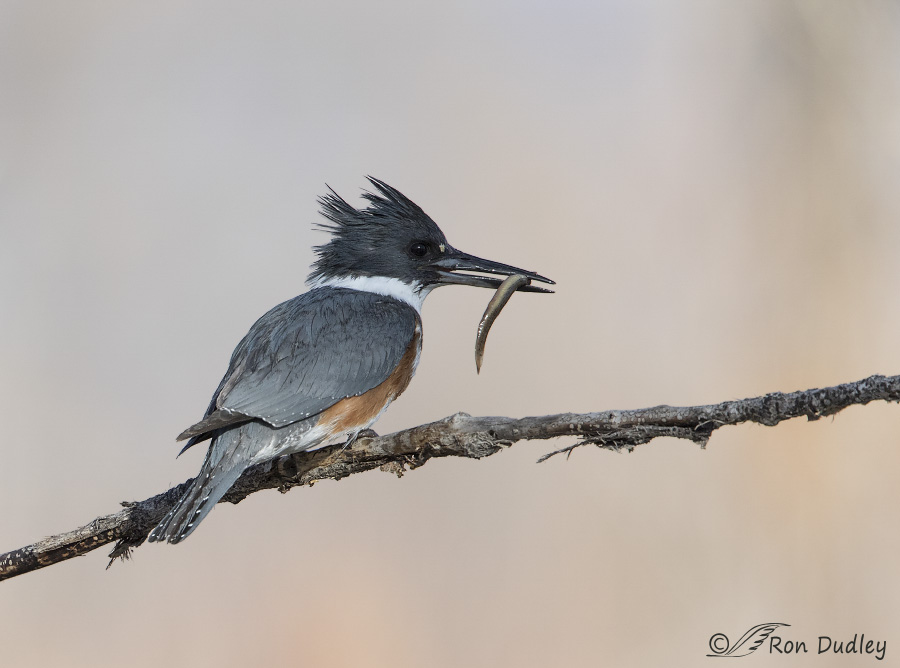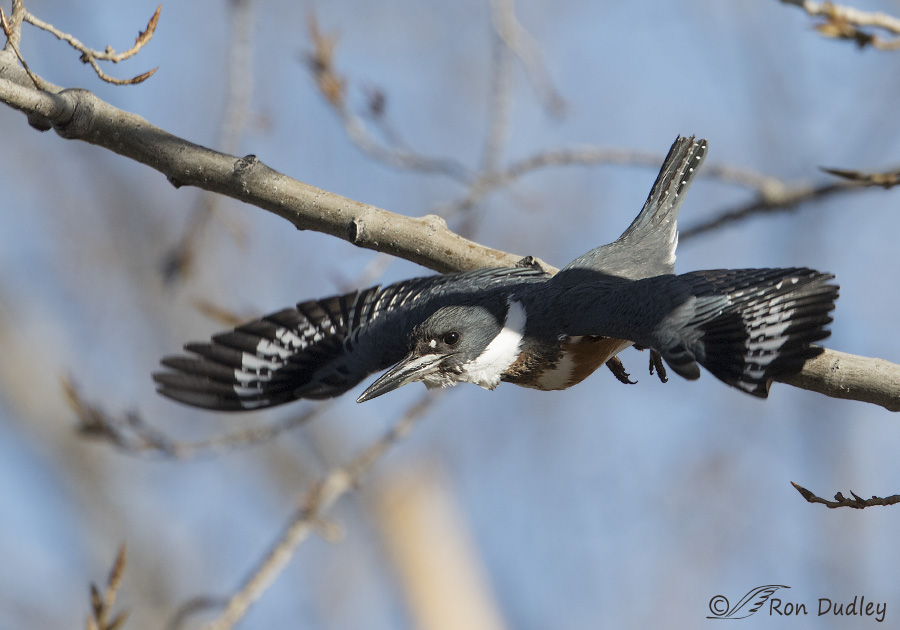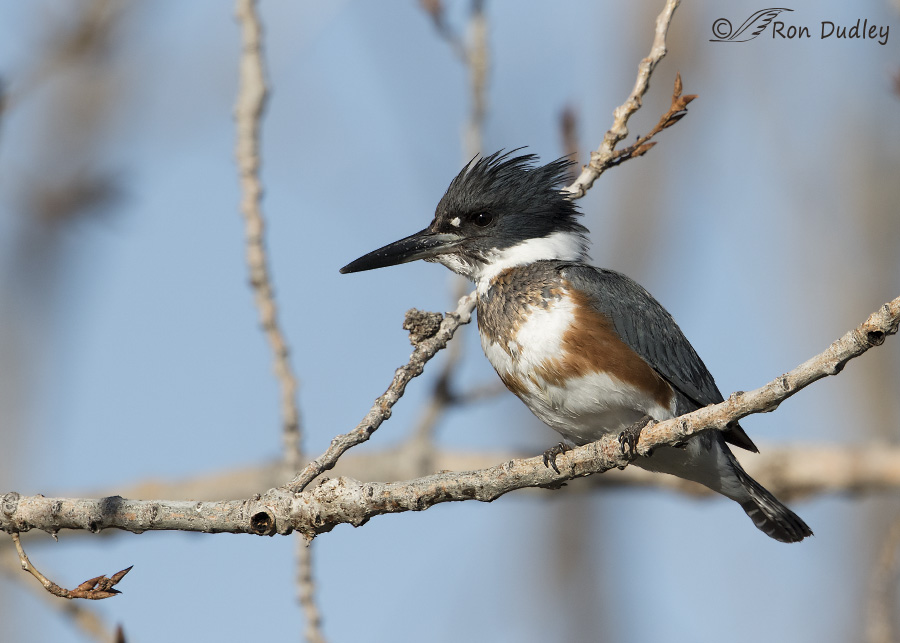I’ve been looking for her most days this week but she seems to have certain requirements before she’ll show up. So far she has never appeared when there’s been enough wind to significantly ruffle the surface of the water (which has been most days this week). Such conditions would likely make it difficult or impossible for her to spot fish below the surface.
All three times I’ve seen her she’s made her appearance within minutes of the same time in the afternoon. It’s easy to know when she shows up because she announces her arrival with her incessant and harsh rattling call. She seems to be on a strict schedule.

1/1600, f/7.1, ISO 500, Canon 7D Mark II, Canon EF 500mm f/4L IS II USM + 1.4 tc, not baited, set up or called in
She wasn’t as cooperative yesterday as she’s been in the past (no Cooper’s Hawk showed up this time to push her into a tree near me) but she was close enough to impress me with her fishing prowess. Though she twice aborted a dive before she hit the water I never saw her actually make the plunge without coming up with a fish. In three of the four times I was close enough to clearly see the fish which were obviously Weather Loaches (as this one is) and the fourth one may have been too. It’s becoming increasingly clear to me that these invasive loaches have become a mainstay in the diets of many of our fish-eating birds.

1/4000, f/6.3, ISO 640, Canon 7D Mark II, Canon EF 500mm f/4L IS II USM + 1.4 tc, not baited, set up or called in
I tried often to catch her at take-off but for a variety of reasons this was the best I could do. She is quick!

1/4000, f/7.1, ISO 500, Canon 7D Mark II, Canon EF 500mm f/4L IS II USM + 1.4 tc, not baited, set up or called in
Her preferred fishing perches were usually cluttered with branches so this is the cleanest close shot I was able to get of her. Yesterday was one of our first truly spring-like days and since it was Saturday there was a lot of human foot-traffic along the river so I believe she felt safer buried in branches like this.
The rufous belly band of the female Belted Kingfisher makes this species one of the few birds in North America in which the female is more colorful than the male.
I know I’ve been posting a lot of kingfisher images lately but I shoot what I see and I post what I shoot. It’s just the nature of the beast.
Ron


Sensational series Ron!
Charlotte
LOVE that take off pose. Determination, grace, style.
Anti-social? Of course. Unless the socialites share my obsessions (quietly).
“Anti-social? Of course. Unless the socialites share my obsessions (quietly).”
That pretty much says it for me too, EC.
Oh how I enjoyed that launching picture! ZOOOOOOM!
Zoom is right, Arwen! I got so tired of hearing my shutter click AFTER the bird was already out of the frame…
(Insert standing repetitive redundant WOW! here) I’ve fallen in love with this girl–and yes, I’m easy with birds. What of it? 😀 I love the takeoff shot–just spectacularly beautiful. And the feather patterns–you just gotta ask, “How do you DO that?” Yes, I know there are scientific reasons, but really, how do you DO that? LOL!
And Jo Ann nailed it. We love spending our mornings with you. Thank you!
I enjoy the “company” too, Laura. Very much. And to think that some of my friends think of me as being almost “antisocial” – humbug!
Don’t feel bad, my family thinks I’m more interested in taking nature pictures than anything else – humbug too!!
What I love about county living – no “crowds” of people most of the time. “Antisocial” is a relative term it seems. 🙂
Great shots Ron!
Evolution is an interesting event, but also fairly logical. Whatever characteristic(s) insures survival of a species will be the characteristics that will sustain that species and are the ones we humans will see. I am sure there is an evolutionary reason for the female having a belly band. Maybe more cryptic while in the burrow?
Who knows? Makes one wonder though, doesn’t it, Dick? Thank you.
Ron, you can post kingfishers as often as you like! They never show up anywhere in my viewing area except along the busy road from Dillon to Twin Bridges, where there are no shoulders or stopping places. They sit on the bridge and wait for the fish. They are so fast that I just get a glimpse as they dive. Your beautiful shots show me what I am missing!!
I know that road well, Jane.
One of the few places I’ve seen kingfishers in your general area is at the bridge very close to the Beaver Canyon Stage Station Historical Marker at the Stoddard Creek exit from I-15.
And BTW, my great grandfather spent many a night at that stage station back in the 1870’s when he was hauling freight by wagon from Utah to the Montana gold fields. I think of him often when I’m there and I’m there a lot in the summertime.
I am new to your blog and amazing photography, Ron. Thank you for the photos of the belted kingfisher. One circled our campground in 2001 when we were on an Outdoor Semester with our students. One of our Outdoor leaders identified the bird before it was lost from view in the trees. My journal says it had an erratic flight pattern. Thank you for this wonderful close-up view.
Welcome to my blog, Elizabeth.
I still remember my first confirmed kingfisher sighting many years ago. They’re memorable birds.
No such thing as too many kingfisher pics! Thanks for being you and doing what you do!
“No such thing as too many kingfisher pics!”
That’s pretty much the way I feel, Poppy.
Good morning, Beast! Glad you’re posting so many shots of this elusive bird…get ’em and post them when you can!!! You never know when or if you’ll get another chance…in which case, we all lose….love the take off pic and the portrait (last)…I’ve wondered what function the white spot in front of the eye serves….
I’ve wondered the same thing, Patty. I tried to look it up earlier this week but came up empty.
As always a joy to share in your adventures!! 😊
Thank you, Lois.
Beautiful shots, Ron. 🙂 They do have their schedules and “screaming” through an area to say “I’m here” 🙂
As far as I can tell this bird’s schedule is like clockwork, Judy – a bird after my own heart since I’m such a creature of habit.
LOL, Ron!! I think she knows you are making her famous!! Again, she is a beauty with lots of personallity!! My favorite is the dive shot. By the way, you never disappoint – your blog is very special – to all of us who spend our mornings with you!!
Thanks for the kind words, Jo Ann. I’m sure I disappoint some occasionally but I do hope it isn’t very often.